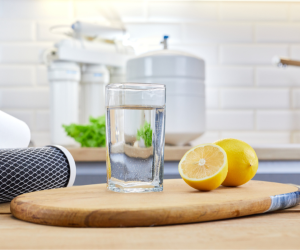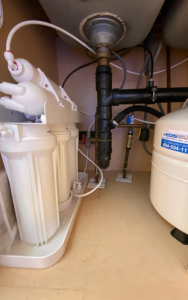Reverse Osmosis 101: How It Works and Why Your Home Might Need It
Clean, great-tasting water isn’t just a luxury, it’s something every home should have. If you’ve ever wondered how to get bottled water quality right from your tap, you’ve probably come across a reverse osmosis (RO) system. But what exactly is it, and does every home really need a reverse osmosis system?
What Is Reverse Osmosis?
Reverse osmosis, often called RO, is a water filtration process that removes dissolved minerals, salts, and contaminants using a semi-permeable membrane.
Think of it as an ultra-fine filter, small enough for water molecules to pass through but tight enough to block impurities. Under pressure, water is forced through the membrane, leaving clean water (called permeate) on one side and concentrated impurities (called reject water) on the other.
How Reverse Osmosis Works: Step by Step
- Pre-Filtration: – Removes sediment, rust, and chlorine using sediment and carbon filters.
- The RO Membrane: – Forces water through the membrane, removing dissolved minerals and microscopic contaminants.
- Storage & Post-Filtration: – Stores clean water in a tank, then “polishes” it for great taste before reaching your tap.
- Wastewater (Reject Line): – Flushed impurities are sent down the drain. Modern RO systems are designed to be highly efficient.
What does Reverse Osmosis remove?
- Dissolved salts and minerals (TDS)– excess calcium and magnesium that make water “hard” and can leave scale on faucets and appliances.
- Lead, arsenic, and heavy metals – found in old pipes, well water, or areas with certain industrial activity.
- Fluoride and PFAS (“forever chemicals”) – PFAS are in things like non-stick cookware, water-repellent fabrics, firefighting foam, and some food packaging; they persist in the environment and can accumulate in the body.
- Microplastics– tiny plastic particles from bottled water, packaging, or environmental pollution.
- VOCs (volatile organic compounds) – gases or vapours from paints, gasoline, industrial solvents, or cleaning agents. Examples include chloroform, benzene, and trichloroethylene (TCE).
- Bad tastes and odours – like chlorine, sulfur, or metallic taste from municipal water or well sources.
For complete protection, many homeowners pair their RO system with UV disinfection to neutralize bacteria and viruses.
Why Your Home Might Need Reverse Osmosis
You should consider an RO system if:
- Your water tastes or smells off.
- You are on well water with sediment or mineral issues.
- You want extra protection from trace contaminant.
- You prefer bottled-water quality without the plastic waste.
- You have sensitive uses like aquariums or coffee brewing.
At EDS Pumps & Water Treatment, we always begin with a water test to understand your unique water composition before recommending any system.
Simple Tips for Reliable RO Performance
At EDS, we care about long-term reliability as much as water quality. These key leak-prevention measures help protect your home and your system:
- Automatic Leak Stop Valve – Shuts off water supply automatically if a leak is detected, either mechanically or electronically.
- Drip Tray – Catches small leaks before they cause damage; sensors can be placed inside the tray for added safety.
- Pressure Regulator – Keeps feed pressure below 75 PSI to prevent stress on fittings and tubing.
Maintenance Made Simple
Keeping your RO system running smoothly is easy. Here are a few maintenance tips to keep your RO system in good working order:
- Replace pre-filters every 6–12 months.
- Replace membrane every 2–3 years
- Sanitize and check storage tank annually
- Use a TDS meter to monitor performance
At EDS, we carry filters, membranes, and all replacement parts, plus we can remind you when service is due. Reach out to our Water Quality Specialists at 604-534-1115 or info@edspumps.com for a free service reminder!
Environmental and Cost Considerations
While RO systems do send some water to drain, newer systems are much more efficient. Adding a permeate pump can reduce wastewater and increase flow rate.
Over time, you’ll also save on bottled water costs and enjoy the peace of mind of knowing exactly what’s in your water.
At EDS Pumps & Water Treatment in Langley, our Water Quality Specialists can test your water, explain your results, and recommend the best solution for your home.
Visit us: 23184 Fraser Hwy, Langley BC
Ask an Expert
Learn more
Frequently Asked Questions About Reverse Osmosis
Does reverse osmosis remove healthy minerals from water?
Yes, but most systems now include a remineralization stage to restore calcium and magnesium for taste and balance.
How much water does an RO system waste?
Modern high-efficiency RO systems use up to 75% less water than older models.
Is RO better than a regular water filter?
Yes, while standard filters improve taste, RO provides deeper purification by removing dissolved solids, metals, and PFAS.
How often should I service my RO system?
Replace pre-filters every 6–12 months and membranes every 2–3 years for best performance.
Can I install an RO system myself?
DIY is possible, but professional installation ensures correct pressure and leak prevention and EDS can handle that for you.

